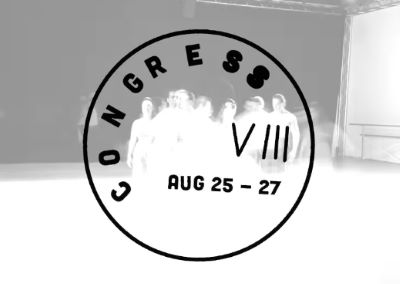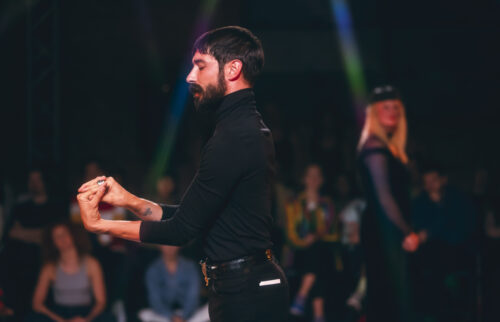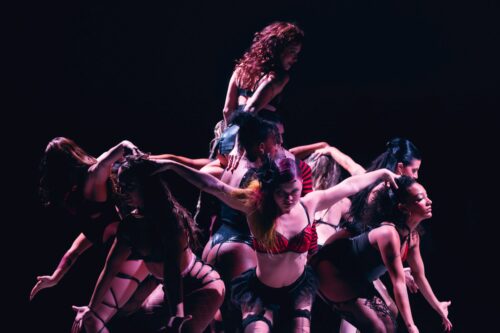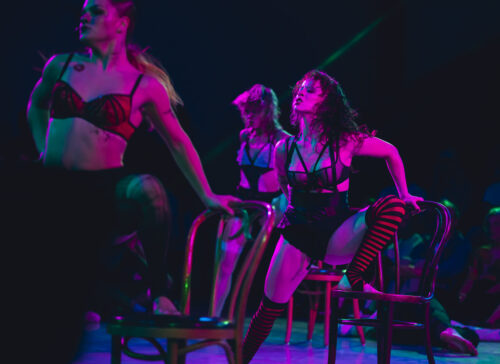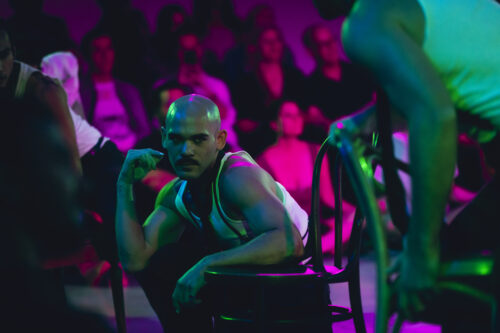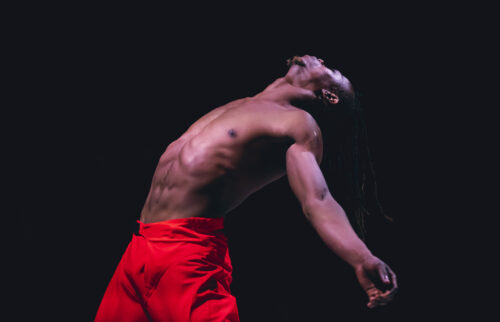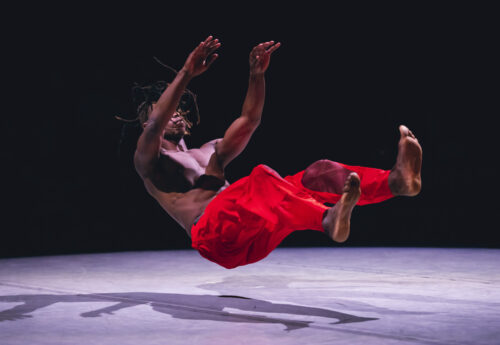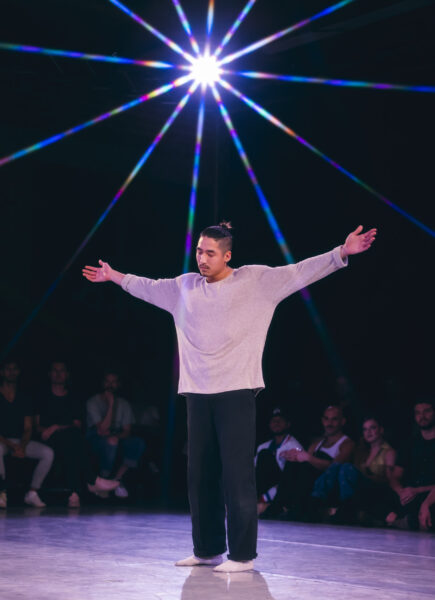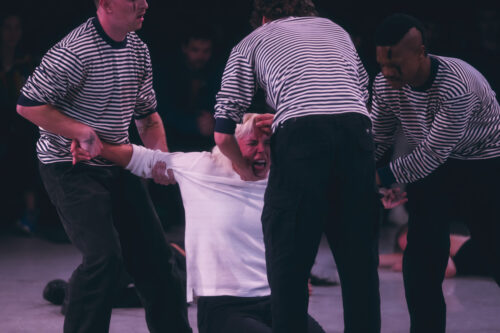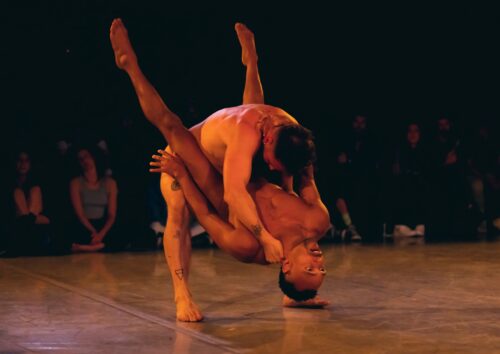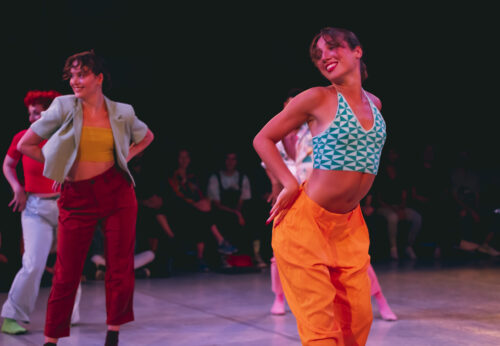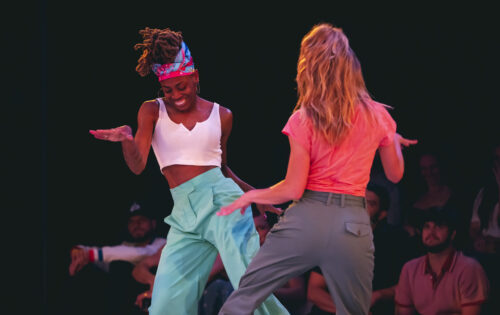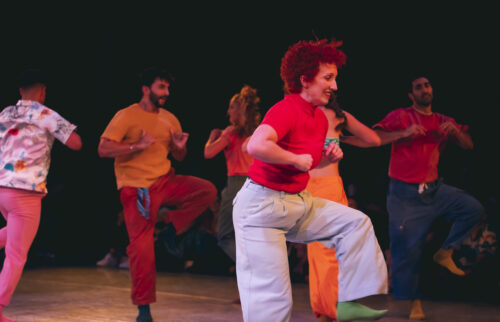WHEN DOES AN ARTIST PREVAIL?
“Dance is a unifying and sacred act,” a blonde woman in velvet black evening gown and netted 1930s “fascinator” cap bellows to a room of dancegoers. “Congress,” she continues, every word laden with religious gravitas, “exists to protect and hold that act’¦” She crouches to her knees, contorting her body, travelling to some interior place. Then, with the next pronouncement, rises and spins to face the audience sitting on all sides of her: “When the entertainment industry still does not see us as assets! When we still do not have a contract!” A skinny bearded man beside her, dressed in black turtleneck and leather boots, picks up the thread. “This is not only a night of mute movement,” he intones. “This is a night of philosophy.”
Welcome to Congress VIII, the “salon-style rotating collective” from LEGALIZE DANCE in partnership with LA Dance Project. The evening, the eighth of its kind, serves up a smattering of curated short dance pieces in an intimate studio setting. Its curators and co-hosts, the well-dressed dancers preaching to the hushed room, are Denna Thomsen and Zak Ryan Schlegel, two LA dance veterans with impressive concert and commercial credits. The evening’s featured choreographers are a smattering of their friends, emerging dancemakers working in a variety of styles. The ethos is one of renegade dancemaking – participating choreographers are affectionately called “con artists”– and the venue is LADP’s headquarters at François Ghebaly, a converted warehouse so far at the edge of the industrial arts district that it is almost in Vernon.
The audience in attendance is young, twenty- and thirty- somethings of a squeaky-clean-yet-artfully-distressed downtown set. They enjoy their “ranch water and cigarettes,” (as I overhear one corset-clad audience member say to another) during the pre-show cocktail hour. As we enter the space, our wrists are stamped with one of three ink circles, denoting General Admission, “V.I.P.,” or Staff. We file into seats and a bleacher encircling the converted studio/stage. The vibe is that of a fashion show, my accompanying friend notes, with VIPs seated closest to the stage and some cross-legged at its edge. One almost expects Anna Wintour to be in attendance, adjudicating behind Chanel shades at her coveted perch.
The lights dim and Zak and Denna walk out to deliver the aforementioned dance manifesto. They foreground the evening’s “philosophy”; each participating choreographer has been asked a central question, which will be revealed over the course of the evening and thematically frame the performance. That question is “When does an artist prevail?” Between each piece, Zak and Denna come out onstage and guide us in verbal interludes in which they reveal the choreographer’s answer to that central question. Around that, they emcee and editorialize. They encourage us to yell and stamp our feet. More than any other element, their running commentary turns the evening from traditional dance performance into a hybrid recital, lecture-demonstration, cabaret, salon, sermon, and stand-up set.
The show begins with a piece in progress from commercial choreographer Robbie Blue entitled “Robbie Blue’s Darling Diamond Dollies.” 10 female dancers vamp, spank themselves, and circle a central couple in dark and skimpy cabaret outfits to Dresden Dolls lyrics (“missed me, missed me, now you gotta kiss me”). 5 male dancers then appear onstage, muscles bulging through tanks as they lift the girls. It’s a combination of dance elements made popular in Euphoria and The Idol, glitter catching the light on the dancers’ faces as they line up, with a modern take on the “Cell Block Tango.” Schleger’s take, which he shared in the interlude after the piece was that Blue makes “future Fosse,” a moniker that perfectly describes what we just witnessed.
The other pieces in the first act are solid but largely unremarkable: a solo from choreographer Jacob Jonas on dancer Baptista Kawa, featuring washboard abs and death-defying backflips, a tense but distractingly performative tango from duo Mayte Valdes and Carlos Barrionuevo, and a strobe-heavy solo from Butoh practitioner Tony Testa. It’s after intermission that the show finds its stride, delivering a slew of memorable and innovative pieces in quick succession.
The first piece of the second half is a solo (“Again and Again”) by Lex Ishimoto. His articulated movements show complete mastery of a contemporary form which blends breakdancing, “flying low” technique, isolations, and fluid floorwork. Though the volume of the accompanying score is ear-drum shattering (perhaps an indulgence meant to reinforce the show’s rebellious attitude, and certainly tolerated by all the cool, soon-to-be-deaf kids in attendance), Ishimoto’s choreography and execution represent a perfectly crisp inner calm, a smooth yet dynamic oasis within the chaos of contemporary movement and the vapidity of attention-seeking performance.
The next piece, “Angry! Mad!” by Nico Lonetree, also known as “King of something tiny somewhere,” features nine dancers in all-black ensembles, black socks, and sneakers pounding the air precisely and forcefully to percussive punk rock. Circling one central woman in white, they flip their hands in coupled formations and shove each other to the ground, only to get up, skip, weight shift, and swarm. They wince in lines of three, emo and angsty in a sweaty mosh pit, jiggle and gyrate, and end the first movement on the ground as corpses splayed radially from the central woman in white. The piece then shifts abruptly as three mimes in black-and-white striped shirts pull a lighter from the central woman’s throat. The trio then snake their bodies in deep bent-knee positions and pluck the air with the lighter, imitating cigarette smoking, to the tinkle of piano keys in Ryuichi Sakamoto’s score.
In one memorable moment, the trio of gondolier-dressed mimes “sweep” the recumbent dancers in black to the side of the space, the latter rolling in lifelike motions like leaves scattered by a rake. In this piece, Lonetree achieves a feat that is rare and magical: he tells a vivid story with no technical or actual narrative elements. With only the arrangement of dancers, costumes, movement, and music, Lonetree taps into the viewer’s unconscious story-creating mechanism in the same way that watchers fill in the moments between frames in film. Without words, Lonetree’s choreography conjures a tapestry of emotional, spunky false memories within the viewer, a direct tap to the unconscious.
The last two pieces of the show are well-placed gems, likely the most memorable part of the evening for anyone in the audience. Mike Tyus’s “Howl” features full nudity (disclaimed in the program and in a comedic bit from Zak and Denna beforehand.) The romantic-and-artistic duo of Mike Tyus and Luca Renzi begin next to each other, fully naked, one faced up and one faced down. Without the music, they begin rolling across the periphery of the stage, tapping and slapping the floor. They build momentum and careen into ever more artistic and athletic stunts, a perfected blend of acro-yoga and contact improv, which then crescendos into a kind of stop-motion seamless double-exposure lightshow.
The footnote to Ginsberg’s seminal poem Howl, read aloud, becomes the score as Tyus and Renzi’s sculptural bodies caress, yawn, kick, and suspend each others’. “Holy, holy, holy,” it begins. “The world is holy! The skin is holy! The nose is holy! The tongue and cock and hand and asshole holy!” The vulnerability of the dancers’ public nudity, their torquing bodies and the way the choreography captures an atlas of human emotions in only momentary glimpses, married to the litany in the background (“Holy New York Holy San Francisco Holy Peoria & Seattle”) elevates this breathless duet to something sacred, shared and felt by everyone in the room. After the piece ends, Zak and Denna emerge onstage. Zak breaks the reverent silence. “It feels like words would only disrupt what we just witnessed.” He then reveals Tyus’ answer to the central thematic question of the night. When does an artist prevail? An artist prevails when they “triumph against all odds, resisting the urge to please.”
The evening is capped with Mandy Moore’s “Shack Attack,” a blinding blast of sugar and color. To the saccharine, upbeat “Love Shack” by the B-52s, Moore brings out the big guns – some of the world’s most highly trained contemporary dancers, masters of the articulation of every minute movement and texture in their bodies – to shimmy, chassé, flick their wrists, and beam from ear to ear in a classic, high-octane jazz number. I described this piece to my friend, who is not a trained dancer (and didn’t see the piece as particularly special) as a moment of inside baseball. Most dancers start as children with some kind of jazz recital piece. To take these spectacular performers (dancers Emily Croch, Aysia Ianiero, George Lawrence, Jillian Meyers, Billy Mustapha, Martha Nichols, Robert Roldan, and Claire Ross), who have toiled for a decade plus in mastering the difference between two degrees of tilt in one’s tailbone, and place them back in a deconstructed smiley jazz number, is genius. And Moore’s version of the smiley 80s rock/jazz number is artfully deconstructed. I ended the show with the others in a standing ovation, impressed and galvanized, left the way good dance should leave someone.
Overall, Congress VIII as an evening of renegade dances, philosophy, Zak and Denna’s quips, and the platforming of “con artists” did, in fact, prevail as a piece of art. Though I am wary of any vibe that is balanced, as this one is, between pretention, spiritual seriousness, and warmth, (at the end, Zak holds his hand to his heart and announces to the reverent room, “You have this family, that I can promise”), I do feel a profound connection to and seriousness in what I witnessed. I’m eager to go to the next Congress (Congress IX) which will be held December 8-10, 2023, and I am looking forward to taking friends who are less acquainted with dance. As seen in this showcase, dance is indeed a unifying and sacred community act. I recommend this performance highly – and if you go, dress in your finest hipster DTLA ensemble, and don’t forget to scream.
photos by Carlos Gonzalez (@the1point8)
